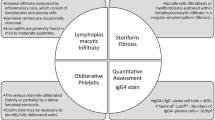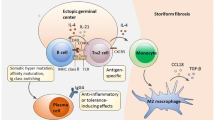Abstract
Wegener’s granulomatosis (WG) is a complex autoimmune disorder that has been transformed from a uniformly lethal process to a chronic disease with a relapsingremitting course. In the setting of frequent relapses, the need to manage cumulative disease damage and drug toxicities has spurred the identification and development of new potent and directed therapies. Biologic agents, which offer the potential for remission-induction and drug-sparing approaches to treat WG, have been studied in several small, open-label clinical series and one large, randomized, placebo-controlled clinical trial. This article discusses the results of these trials and the potential of these biologic agents to treat WG.
Similar content being viewed by others
References and Recommended Reading
Wegener F: Uber eine eigenartige rhinogene Granulomatose mit besonderer beteilig arteriensystems und der nieren [A unique rhinogenic granulomatosis with special involvement of the arterial system and the kidneys]. Beitr Pathol Anat allg Pathol 1939, 102:36–68.
Hoffman GS: "Wegener’s granulomatosis": the path traveled since 1931. Medicine (Baltimore) 1994, 73:325–329.
Hoffman GS, Kerr GS, Leavitt RY, et al.: Wegener granulomatosis: an analysis of 158 patients. Ann Intern Med 1992, 116:488–498.
Abdou NI, Kullman GJ, Hoffman GS, et al.: Wegener’s granulomatosis: survey of 701 patients in North America. Changes in outcome in the 1990s. J Rheumatol 2002, 29:309–316.
Walton EW: Giant-cell granuloma of the respiratory tract (Wegener’s granulomatosis). Br Med J 1958, 34:265–270.
Hollander D, Manning RT: The use of alkylating agents in the treatment of Wegener’s granulomatosis. Ann Intern Med 1967, 67:393–398.
Fauci AS, Wolff SM: Wegener’s granulomatosis: studies in eighteen patients and a review of the literature. Medicine (Baltimore) 1973, 52:535–561.
Courcoutsakis NA, Langford CA, Sneller MC, et al.:Orbital involvement in Wegener granulomatosis: MR findings in 12 patients. J Comput Assist Tomogr 1997, 21:452–458.
Langford CA, Sneller MC, Hallahan CW, et al.: Clinical features and therapeutic management of subglottic stenosis in patients with Wegener’s granulomatosis. Arthritis Rheum 1996, 39:1754–1760.
Seo P, Min YI, Holbrook, et al.: Damage caused by Wegener’s granulomatosis and its treatment: prospective data from the Wegener’s Granulomatosis Etanercept Trial (WGET). Arthritis Rheum 2005, 52:2168–2178.
Sarraf P, Sneller MC: Pathogenesis of Wegener’s granulomatosis: current concepts. Expert Rev Mol Med 2005, 7:1–19.
Kerr GS, Fleisher TA, Hallahan CW, et al.: Limited prognostic value of changes in antineutrophil cytoplasmic antibody titers in patients with Wegener’s granulomatosis. Adv Exp Med Biol 1993, 336:411–414.
Niles JL: Value of tests for antineutrophil cytoplasmic autoantibodies in the diagnosis and treatment of vasculitis. Curr Opin Rheumatol 1993, 5:18–24.
Boomsma MM, Stegeman CA, van der Leig, et al.:Prediction of relapses in Wegener’s granulomatosis by measurement of antineutrophil cytoplasmic antibody levels: a prospective study. Arthritis Rheum 2000, 43:2025–2033.
Falk RJ, Terrell RS, Charles LA, Jennette JC: Anti-neutrophil cytoplasmic autoantibodies induce neutrophils to degranulate and produce oxygen radicals in vitro. Proc Natl Acad Sci U S A 1990, 87:4115–4119.
Jennette JC, Xiao H, Falk RJ: Pathogenesis of vascular inflammation by anti-neutrophil cytoplasmic antibodies. J Am Soc Nephrol 2006, 17:1235–1242.
Xiao H, Heeringa P, Hu P, et al.: Antineutrophil cytoplasmic autoantibodies specific for myeloperoxidase cause glomerulonephritis and vasculitis in mice. J Clin Invest 2002, 110:955–963. This article describes the first animal model for tissue injury induced by myeloperoxidase-antineutrophil cytoplasmic autoantibodies. The clinical phenotype produced with the MPO knockout mice included some but not all of the clinical features of Wegener’s granulomatosis.
Pfister H, Ollert M, Frohlich LF, et al.: Antineutrophil cytoplasmic autoantibodies against the murine homolog of proteinase 3 (Wegener autoantigen) are pathogenic in vivo. Blood 2004, 104:1411–1418. This review uses the strategy employed in the MPO-ANCA knockout mouse model to evaluate the role of PR3-ANCA immunopathogenesis.
Sneller MC: Granuloma formation, implications for the pathogenesis of vasculitis. Cleve Clin J Med 2002, 69(Suppl 2):SII40-SII43.
Aries PM, Lamprecht P, Gross WL: Wegener’s granulomatosis: a view from the granulomatous side of the disease. Isr Med Assoc J 2005, 7:768–773.
Ludviksson BR, Sneller MC, Chua KS, et al.: Active Wegener’s granulomatosis is associated with HLA-DR+ CD4+ T cells exhibiting an unbalanced Th1-type T cell cytokine pattern: reversal with IL-10. J Immunol 1998, 160:3602–3609.
Lamprecht P, Kumanovics G, Mueller A, et al.: Elevated monocytic IL-12 and TNF-alpha production in Wegener’s granulomatosis is normalized by cyclophosphamide and corticosteroid therapy. Clin Exp Immunol 2002, 128:181–186.
Schnabel A, Reuter M, Gloeckner K, et al.: Bronchoalveolar lavage cell profiles in Wegener’s granulomatosis. Respir Med 1999, 93:498–506.
Komocsi A, Lamprecht P, Csernok E, et al.: Peripheral blood and granuloma CD4(+)CD28(-) T cells are a major source of interferon-gamma and tumor necrosis factor-alpha in Wegener’s granulomatosis. Am J Pathol 2002, 160:1717–1724.
Noronha IL, Kruger C, Andrassy K, et al.: In situ production of TNF-alpha, IL-1 beta and IL-2R in ANCA-positive glomerulonephritis. Kidney Int 1993, 43:682–692.
Steiner K, Moosig F, Csernok E, et al.: Increased expression of CTLA-4 (CD152) by T and B lymphocytes in Wegener’s granulomatosis. Clin Exp Immunol 2001, 126:143–150.
Lamprecht P, Moosig F, Csernok E, et al.: CD28 negative T cells are enriched in granulomatous lesions of the respiratory tract in Wegener’s granulomatosis. Thorax 2001, 56:751–757.
Csernok E, Ai M, Gross WL, et al.: Wegener’s autoantigen induces maturation of dendritic cells and licences them for Th1 priming via the protease-activated receptor-2 pathway. Blood 2006, Epub ahead of print. This paper elucidates the role of proteinase 3 in dendritic cell activation in Wegener’s granulomatosis.
Langford CA, Sneller MC: Update on the diagnosis and treatment of Wegener’s granulomatosis. Adv Intern Med 2001, 46:177–206.
Sneller MC, Hoffman GS, Talar-Williams C, et al.: An analysis of forty-two Wegener’s granulomatosis patients treated with methotrexate and prednisone. Arthritis Rheum 1995, 38:608–613.
Metzler C, Fink C, Lamprecht P, et al.: Maintenance of remission with leflunomide in Wegener’s granulomatosis. Rheumatology (Oxford) 2004, 43:315–320. This report presents the first use of leflunomide for the maintenance of remission in 20 patients with Wegener’s granulomatosis.
Langford CA, Talar-Williams C, Sneller MC: Mycophenolate mofetil for remission maintenance in the treatment of Wegener’s granulomatosis. Arthritis Rheum 2004, 51:278–283.
Jayne D, Rasmussen N, Andrassy K, et al.: A randomized trial of maintenance therapy for vasculitis associated with antineutrophil cytoplasmic autoantibodies. N Engl J Med 2003, 349:36–44.
Langford CA, Talar-Williams C, Barron KS, Sneller MC: A staged approach to the treatment of Wegener’s granulomatosis: induction of remission with glucocorticoids and daily cyclophosphamide switching to methotrexate for remission maintenance. Arthritis Rheum 1999, 42:2666–2673.
Langford CA, Talar-Williams C, Barron KS, Sneller MC: Use of a cyclophosphamide-induction methotrexate-maintenance regimen for the treatment of Wegener’s granulomatosis: extended follow-up and rate of relapse. Am J Med 2003, 114:463–469.
De Groot K, Rasmussen N, Bacon PA, et al.: Randomized trial of cyclophosphamide versus methotrexate for induction of remission in early systemic antineutrophil cytoplasmic antibody-associated vasculitis. Arthritis Rheum 2005, 52:2461–2469. This is the first randomized controlled clinical trial demonstrating that methotrexate can replace cyclophosphamide in early systemic ANCA-associated vasculitis. The high relapse rate provides a rationale for maintenance therapy beyond 12 months.
The Wegener’s Granulomatosis Etanercept Trial (WGET) Research Group: Etanercept plus standard therapy for Wegener’s granulomatosis. N Engl J Med 2005, 352:351–361. This article presents the first large, placebo-controlled clinical trial evaluating the use of anti-tumor necrosis factor agent in Wegener’s granulomatosis. The trial was powered to study the efficacy of etanercept for maintenance therapy.
Stone JH, Holbrook JT, Marriott MA, et al.: Solid malignancies among patients in the Wegener’s granulomatosis etanercept trial. Arthritis Rheum 2006, 54:1608–1618.
Knight A, Askling J, Ekbom A: Cancer incidence in a population-based cohort of patients with Wegener’s granulomatosis. Int J Cancer 2002, 100:82–85.
Wolfe F, Michaud K: Fatigue, rheumatoid arthritis, and anti-tumor necrosis factor therapy: an investigation in 24,831 patients. J Rheumatol 2004, 31:2115–2120.
Sandborn WJ, Hanauer SB, Katz S, et al.: Etanercept for active Crohn’s disease: a randomized, double-blind, placebo-controlled trial. Gastroenterology 2001, 121:1088–1094.
Utz JP, Limper AH, Kalra S, et al.: Etanercept for the treatment of stage II and III progressive pulmonary sarcoidosis. Chest 2003, 124:177–185.
Baert F, Noman M, Vermeire S: Influence of immunogenicity on the long-term efficacy of infliximab in Crohn’s disease. N Engl J Med 2003, 348:601–608.
Rigby WF: Distinct mechanisms of action of tumor necrosis factor antagonists: what are the clinical implications? Semin Arthritis Rheum 2005, 345 Suppl 1):1–2. This review discusses the distinct mechanisms of action of currently marketed anti-tumor necrosis factor drugs.
Haraoui B: Differentiating the efficacy of the tumor necrosis factor inhibitors. Semin Arthritis Rheum 2005, 34(5 Suppl 1):7–11.
Booth A, Harper L, Hammad T, et al.: Prospective study of TNFα blockade with infliximab in anti-neutrophil cytoplasmic antibody-associated systemic vasculitis. J Am Soc Nephrol 2004, 15:717–721. This report presents the largest prospective trial evaluating the efficacy of infliximab as an adjunct to the standard therapy in patients with ANCA-associated vasculitis.
Booth AD, Jefferson HJ, Ayliffe W, et al.: Safety and efficacy of TNFα blockade in relapsing vasculitis [letter]. Ann Rheum Dis 2002, 61:559.
Lamprecht P, Voswinkel J, Lilienthal T, et al.: Effectiveness of TNF-α blockade with infliximab in refractory Wegener’s granulomatosis. Rheumatology (Oxford) 2002, 41:1303–1307.
Bartolucci P, Ramanoelina J, Cohen P, et al.: Efficacy of the anti-TNF-α antibody infliximab against refractory systemic vasculitides: an open pilot study on 10 patients. Rheumatology (Oxford) 2002, 41:1126–1132.
Perosa F, Favoino E, Caragnano MA, et al.: CD20: a target antigen for immunotherapy of autoimmune diseases. Autoimmun Rev 2005, 4:526–531.
Cambridge G, Leandro MJ, Edwards JC, et al.: Serologic changes following B lymphocyte depletion therapy for rheumatoid arthritis. Arthritis Rheum 2003, 48:2146–2154.
Sneller MC: Rituximab and Wegener’s granulomatosis: Are B cells a target in vasculitis treatment? Arthritis Rheum 2005, 52:1–5.
Edwards JC, Szczepanski L, Szechinski J, et al.: Efficacy of B-cell-targeted therapy with rituximab in patients with rheumatoid arthritis. N Engl J Med 2004, 350:2572–2581.
De Vita S, Zaja F, Sacco S, et al.: Efficacy of selective B cell blockade in the treatment of rheumatoid arthritis: evidence for a pathogenetic role of B cells. Arthritis Rheum 2002, 46:2029–2033.
Looney RJ, Anolik JH, Campbell D, et al.: B cell depletion as a novel treatment for systemic lupus erythematosus: a phase I/II dose-escalation trial of rituximab. Arthritis Rheum 2004, 50:2580–2589.
Looney RJ: B cells as a therapeutic target in autoimmune diseases other than rheumatoid arthritis. Rheumatology (Oxford) 2005, 44(Suppl 2):ii13-ii17.
Keogh KA, Ytterberg SR, Fervenza FC, et al.: Rituximab for refractory Wegener’s granulomatosis: report of a prospective, open-label pilot trial. Am J Respir Crit Care Med 2006, 173:180–187.
Aries PM, Hellmich B, Both M, et al.: Lack of efficacy of rituximab in Wegener’s granulomatosis with refractory granulomatous manifestations. Ann Rheum Dis 2005, Epub ahead of print.
Eriksson P: Nine patients with anti-neutrophil cytoplasmic antibody-positive vasculitis successfully treated with rituximab. J Intern Med 2005, 257:540–548.
Keogh KA, Wylam ME, Stone JH, Specks U: Induction of remission by B lymphocyte depletion in eleven patients with refractory antineutrophil cytoplasmic antibody-associated vasculitis. Arthritis Rheum 2005, 52:262–268. This is the first prospective trial on rituximab given in addition to standard therapy in patients with antibody-associated vasculitis. The efficacy of rituximab is difficult to interpret because of multiple co-medications. This trial provides insight on the effects of B-cell blockade on ANCA.
Rituximab for the treatment of Wegener’s granulomatosis and microscopic polyangiitis. http://www.clinicaltrials.gov/ct/ show/NCT00104299?order=2. Accessed June 3, 2006.
Talar-Williams C, Hijazi YM, Walther MM, et al.:Cyclophosphamide-induced cystitis and bladder cancer in patients with Wegener granulomatosis. Ann Intern Med 1996, 124:477–484.
Author information
Authors and Affiliations
Corresponding author
Rights and permissions
About this article
Cite this article
Sarraf, P., Kay, J., Friday, R.P. et al. Wegener’s granulomatosis: Is biologic therapy useful?. Curr Rheumatol Rep 8, 303–311 (2006). https://doi.org/10.1007/s11926-006-0014-6
Issue Date:
DOI: https://doi.org/10.1007/s11926-006-0014-6




